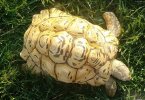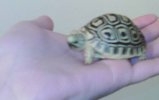leopardmom
New Member
Hi! I'm new here and this is my first post. I've had a south african leopard tortoise for almost 15 years and this is the first time she might be sick. She recently came out of hibernation/brumation in mid/late March (kept indoors, I haven't always lived with her but from what I remember she just goes to sleep every winter for at least the past few years) and I noticed her eyes were looking a bit swollen/puffy. (I'll try to post pics later.) Took her to an exotic vet for the first time a couple weeks ago. (Her eyes looked a bit odd before hibernation in late Oct/early Nov but we just thought they were irritated from taking her outside during the last few warm days of the fall. I cleaned them and then the issues seemed to subside. Fast forward post hibernation and her eyes looked a bit odd again...)
The vet said the inside of her mouth looked nice and pink, nose looked clear/no bubbles, her weight was good, her eyes were clear but her third eyelids were elevated/swollen, and they were concerned about how her breathing sounded and thought it might be a RI. I asked what the breathing sounded like bc my tort has been "whistling/squeaking" for years. I asked if the breathing sounded more whistle-y or gurgle-y and the vet said they think it sounded gurgle-y. This was a couple of weeks ago. I've been trying to listen to her breathing since then and it's really hard to tell if it sounds different than usual. At the time the vet gave me a couple of options: do some testing or start her up on antibiotics. I think the tests would check other secondary issues rather than confirm whether or not she has an RI, but I can't remember. One of those tests included looking at a oral swab, I think. So at the time, I agreed to take the antibiotics for her and no testing. When I was given the meds I was told two people should administer them bc it can be difficult to do it alone for someone of her size. I am currently alone right now waiting for my family member to come back and the vet said it was likely okay to wait a couple weeks to give the medicine but in the meantime take extra care of her and increase temps in her husbandry. They gave some good general advice about tortoise diet as well. Currently, she eats lots and lots of grass/weeds as long as it's warm outside, arugula, bok choy, dandelions, and belgian endives in her diet. A couple slices of tomato and few carrot shreddings 1-2x a week. The vet said it could be vitamin A deficiency as well which I also thought of. Any advice on how to carefully supplement/improve her diet to make sure she is getting her vitamin A? I want to be really careful about what I feed her. I already supplement her diet w dusting of a plant calcium complex and D3 about 2x week, esp as we are still transitioning into summer months before she can get plenty of sun. Also, my tort unfortunately does have pyramiding from when she was younger. But over the years her growth has seemed to improve with changes in husbandry and diet. We did change homes a couple years ago and she was with a pet sitter in another home for a couple weeks early in the fall, so I'm not sure if these changes in environment could have been factors or if she just got exposed to something somehow.
The vet had excellent advice on husbandry and their practice was highly rated so I trust their advice and protocols. They didn't have vets that specialized in tortoises specifically but did have general reptile vets who had seen torts before. But I'm still really anxious about administering these antibiotics and I'm wondering if I should just bring her back and ask to run some tests before I start her on the medications.
***Does anyone have any experience with giving their torts (especially leopards) celtiofur (naxcel), amikacin, and meloxicam all at once?*** They are injections to be done at the front arms where there is loose skin is what the vet tech told me. I'm not sure if they are all subcutaneous but I'm going to call and double check just to be sure. My family member is coming back in a couple days and I wanted to start the antibiotics as soon as they get home but now I'm really nervous about it. I trust this vet but I'm wondering if I should just go back and run some tests and/or get an x-ray -- or if these antibiotics will probably do the trick. I want her to get better ASAP, but I also don't want to make it worse. Good news is right now my tort is happily eating everyday, gets daily warm soaks for 20-30 minutes, drinks water daily, gets at least 1.5 hours of direct sun daily if it is above 70 outside. Weather was a bit too cool this past week to take her out but she has just been warming herself next to her heater inside. Still transitioning into the warmer months but as it gets warmer we let her sunbathe outside early in the morning for at least a couple of hours as long as she feels comfortable in the sun/heat, after which she usually rests or walks around indoors. And then we take her out again in the afternoon if she wants to sunbathe more and/or graze.
Also, I've been putting Vetericyn eye wash in her eyes daily. She doesn't love it but it definitely helps keep her eyes clean and reduces a bit of inflammation. Anyone have additional advice on that? Does anyone have experience using Zoo Med Repti Turtle eye drops on a tortoise? I was wondering if I should try that to address possible vitamin A deficiency.
Thank you!
The vet said the inside of her mouth looked nice and pink, nose looked clear/no bubbles, her weight was good, her eyes were clear but her third eyelids were elevated/swollen, and they were concerned about how her breathing sounded and thought it might be a RI. I asked what the breathing sounded like bc my tort has been "whistling/squeaking" for years. I asked if the breathing sounded more whistle-y or gurgle-y and the vet said they think it sounded gurgle-y. This was a couple of weeks ago. I've been trying to listen to her breathing since then and it's really hard to tell if it sounds different than usual. At the time the vet gave me a couple of options: do some testing or start her up on antibiotics. I think the tests would check other secondary issues rather than confirm whether or not she has an RI, but I can't remember. One of those tests included looking at a oral swab, I think. So at the time, I agreed to take the antibiotics for her and no testing. When I was given the meds I was told two people should administer them bc it can be difficult to do it alone for someone of her size. I am currently alone right now waiting for my family member to come back and the vet said it was likely okay to wait a couple weeks to give the medicine but in the meantime take extra care of her and increase temps in her husbandry. They gave some good general advice about tortoise diet as well. Currently, she eats lots and lots of grass/weeds as long as it's warm outside, arugula, bok choy, dandelions, and belgian endives in her diet. A couple slices of tomato and few carrot shreddings 1-2x a week. The vet said it could be vitamin A deficiency as well which I also thought of. Any advice on how to carefully supplement/improve her diet to make sure she is getting her vitamin A? I want to be really careful about what I feed her. I already supplement her diet w dusting of a plant calcium complex and D3 about 2x week, esp as we are still transitioning into summer months before she can get plenty of sun. Also, my tort unfortunately does have pyramiding from when she was younger. But over the years her growth has seemed to improve with changes in husbandry and diet. We did change homes a couple years ago and she was with a pet sitter in another home for a couple weeks early in the fall, so I'm not sure if these changes in environment could have been factors or if she just got exposed to something somehow.
The vet had excellent advice on husbandry and their practice was highly rated so I trust their advice and protocols. They didn't have vets that specialized in tortoises specifically but did have general reptile vets who had seen torts before. But I'm still really anxious about administering these antibiotics and I'm wondering if I should just bring her back and ask to run some tests before I start her on the medications.
***Does anyone have any experience with giving their torts (especially leopards) celtiofur (naxcel), amikacin, and meloxicam all at once?*** They are injections to be done at the front arms where there is loose skin is what the vet tech told me. I'm not sure if they are all subcutaneous but I'm going to call and double check just to be sure. My family member is coming back in a couple days and I wanted to start the antibiotics as soon as they get home but now I'm really nervous about it. I trust this vet but I'm wondering if I should just go back and run some tests and/or get an x-ray -- or if these antibiotics will probably do the trick. I want her to get better ASAP, but I also don't want to make it worse. Good news is right now my tort is happily eating everyday, gets daily warm soaks for 20-30 minutes, drinks water daily, gets at least 1.5 hours of direct sun daily if it is above 70 outside. Weather was a bit too cool this past week to take her out but she has just been warming herself next to her heater inside. Still transitioning into the warmer months but as it gets warmer we let her sunbathe outside early in the morning for at least a couple of hours as long as she feels comfortable in the sun/heat, after which she usually rests or walks around indoors. And then we take her out again in the afternoon if she wants to sunbathe more and/or graze.
Also, I've been putting Vetericyn eye wash in her eyes daily. She doesn't love it but it definitely helps keep her eyes clean and reduces a bit of inflammation. Anyone have additional advice on that? Does anyone have experience using Zoo Med Repti Turtle eye drops on a tortoise? I was wondering if I should try that to address possible vitamin A deficiency.
Thank you!

